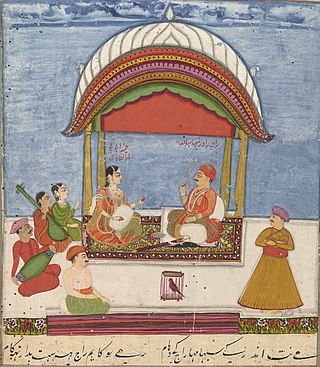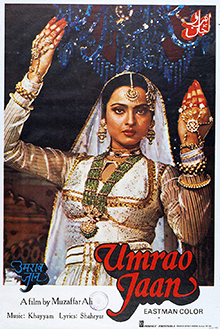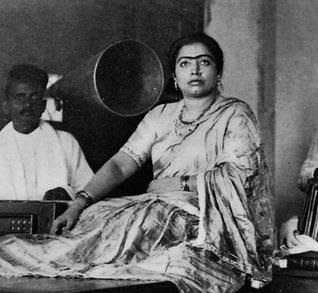
Thumri is a vocal genre or style of Indian music. The term "thumri" is derived from the Hindi verb thumuknaa, which means "to walk with a dancing gait in such a way that the ankle-bells tinkle." The form is, thus, connected with dance, dramatic gestures, mild eroticism, evocative love poetry and folk songs, especially from Uttar Pradesh, though there are regional variations.

Kathak is one of the eight major forms of Indian classical dance. Its origin is attributed to the traveling bards in ancient northern India known as Kathakar ("storyteller"), who communicated stories from the Hindu epics and mythology through dance, songs and music. Its name derives from the Sanskrit word katha which means "story", and kathakar which means "the one who tells a story", or "to do with stories".

A tawaif was a highly successful courtesan, dancing girl or female entertainer who catered to the nobility of the Indian subcontinent, particularly during the Mughal era. Many tawaifs were forced to go into prostitution due to a lack of opportunities by the time of the British Raj.

Umrao Jaan is a 1981 Indian period musical drama film directed by Muzaffar Ali and starring Rekha as the eponymous character. Based on the 1905 Urdu novel Umrao Jaan Ada, the film tells the story of a Lucknow tawaif and poet, and her rise to fame.
Heera Mandi, is a neighbourhood and bazaar located in the Walled City of Lahore. It is specifically known as the red light district of Lahore, Pakistan.

The nautch was a popular court dance performed by girls in later Mughal and colonial India. The word "nautch" was a British corruption of Nachna, the Hindi verb to dance. The culture of the performing art of the nautch rose to prominence during the later period of Mughal Empire and the rule of the East India Company.
Kumudini Lakhia is an Indian Kathak dancer and choreographer based in Ahmedabad, Gujarat, where she founded Kadamb School of Dance and Music, an institute of Indian dance and music in 1967.

Umrao Jaan is a 2006 Indian period musical romantic drama film produced and directed by J. P. Dutta, based on the Urdu novel Umrao Jaan Ada and is about the famous Tawaif of the title. Aishwarya Rai stars in the lead role along with Abhishek Bachchan, Shabana Azmi, Sunil Shetty, Divya Dutta, Himani Shivpuri and Kulbhushan Kharbanda in supporting roles.
Mirza Muhammad Hadi Ruswa was an Indian Urdu poet and writer of fiction, plays, and treatises. He served on the Nawab of Awadh's advisory board on language matters for many years. He spoke many languages including Urdu, Greek, and English.

Gauhar Jaan was an Indian singer and dancer from Kolkata. She was one of the first performers to record music on 78 rpm records in India, which was later released by the Gramophone Company of India and resulted in her being known as "the Gramophone girl" and "the first recording superstar of India". Having recorded more than 600 songs in more than ten languages between 1902 and 1920, Jaan is credited with popularising Hindustani classical music such as thumri, dadra, kajri, and tarana during the period.
Umrao Jaan Ada is an Urdu novel by Mirza Hadi Ruswa (1857–1931), first published in 1899. It is considered the first Urdu novel by many and tells the story of a tawaif and poet by the same name from 19th century Lucknow, as recounted by her to the author.
The Muslim social is a film genre in Bollywood that portrays Islamic culture in India. It flourished in the 1950s and 1960s and lasted till the early 1980s. Muslim socials are divided into two categories: "classic Muslim socials" that explore nawabi culture and focus on upper class or elite Muslim families, and "new wave Muslim socials" that portray middle class Muslim families who experience economic problems, discrimination and communal violence. Muslim socials often include ghazals, qawwalis, Urdu poetry and expressions, and musical forms commonly associated with Islamic culture. However, lately the label has also been criticized for cultural ghettoization of minority cinema. Director M.S. Sathyu who made Garam Hava (1973), called it "a skewed way to look at cinema. When there is no Hindu social or Christian social, how can there be a Muslim social".

Mah Laqa Bai, born Chanda Bai, and sometimes referred to as Mah Laqa Chanda, was an Indian 18th century Urdu poet, courtesan (tawaif) and philanthropist based in Hyderabad. In 1824, she became the first female poet to have a diwan of her work, a compilation of Urdu Ghazals named Gulzar-e-Mahlaqa, published posthumously. She lived in a period when Dakhini was making its transition into the highly Persianized Urdu. Her literary contributions provide insight into such linguistic transformations in southern India.

Umrao Jaan Ada is a 1972 Pakistani musical romantic drama film loosely based on the novel of the same name by Mirza Hadi Ruswa and directed by Hassan Tariq with lyrics and screenplay by Saifuddin Saif. Rani played the title role in the film opposite Shahid while Nayyar Sultana, Zmurrud, Aasia, Rangeela and Allauddin appeared in supporting roles. It revolves around the entire life journey of a tawaif from Lucknow and her tragic romance with a Nawab. The film was a golden jubilee hit at the Box office. Lok Virsa Museum screened the film in 2017 as part of special showcase of the feature films in the country.
"In Ankhon Ki Masti Ke" is an Urdu song from the Indian film Umrao Jaan (1981). The music to this song was composed by Khayyam, the lyrics written by Shahryar, and sung by Asha Bhosle.
Hassan Tariq was a Pakistani film director, film producer and screenwriter who was famous for making films like Anjuman, Kaneez, Baharo Phool Barsao and Devar Bhabi.
Niggo was a popular traditional Pakistan dancer and film actress. She mainly worked on Punjabi and Urdu films in the 60s.

Showgirls of Pakistan is a 2020 documentary film by Lahore-born filmmaker Saad Khan, about the commercial Mujra industry of Pakistan.

Umrao Jaan Ada is a Pakistani television series based on Mirza Hadi Ruswa's novel Umrao Jaan Ada. It is directed by Raana Sheikh and first aired on Geo Entertainment. Aamina Bano played the title role of Umrao Jaan. The supporting cast features actors Bushra Ansari, Faisal Qureshi, Imran Abbas, Humayun Saeed and Mehmood Aslam in prominent roles. Made with a heavy production budget, it is one of the expensive television series made in Pakistan. The series depicts the tawaif of Lucknow during the mid-nineteenth century. It was a pioneer portrayal of extramarital sex after Zia's era. Due to having several mujra performances as well, the series was termed as too bold at that time.
Gulzar Begum, also known as Tamancha Jan was a Pakistani folk singer. She was known as The Singing Siren and The Nightingale of Lahore. She was a popular playback singer of 1930s and 1940s in Cinema of India.











